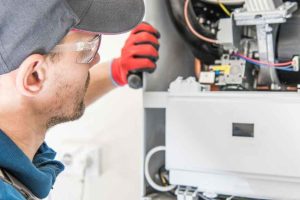Are you tired of stepping into a cold garage during the Winnipeg winter months? Installing a garage heater can make a world of difference, providing warmth and comfort while you work on projects or store your vehicles in Winnipeg’s chilly climate. But the big question is, should you take on the installation yourself or hire a professional in Winnipeg? Let’s dive into the details and figure out which option suits you best for your garage heater Winnipeg.
Step-by-Step Guide for Installing a Garage Heater
Before we delve into the comparison between DIY installation and professional installation, let’s get familiar with the general steps involved in installing a garage heater.

Preparation
- Choose the Right Heater: Consider factors like garage size, insulation, fuel type, budget, and desired features. Ensure the selected heater complies with local building codes and safety regulations.
- Gather Tools and Materials: Depending on the heater type, you might need tools like drills, wrenches, screwdrivers, safety glasses, gloves, and possibly electrical wiring testers and venting materials.
- Clear the Installation Area: Remove any clutter or obstacles from the designated mounting location.
- Turn Off Power and Gas (if applicable): Ensure safety by shutting off electricity and gas supply to the garage before starting any work.
Installation
- Follow the Manufacturer’s Instructions: Each heater comes with specific installation guidelines. Read them carefully and follow them step-by-step to avoid issues.
- Mounting the Heater: Depending on the model, you might need to mount the heater on a wall, ceiling, or floor. Ensure secure fastening using appropriate hardware and following proper load-bearing considerations.
- Electrical/Gas Connections: For electric heaters, follow the instructions for wiring connections to the existing electrical panel or dedicated circuit. If using propane or natural gas, ensure proper connection to the gas line by a licensed professional.
- Venting (if applicable): Some heaters, like propane and natural gas models, require proper venting to expel exhaust fumes. Install venting pipes and fittings according to local codes and manufacturer specifications.
Testing and Safety Checks
- Test the Heater Operation: Once installed, turn on the heater and verify it functions properly according to the set temperature or settings.
- Check for Leaks (if applicable): If using gas, conduct leak tests following the manufacturer’s instructions and local regulations.
- Install Safety Features: Equip the heater with additional safety features such as tip-over shut-off or overheat protection as needed.
Read More:- What Are the Best Garage Heaters?
Comparison of DIY Installation vs Professional Installation
Now that you’re familiar with the installation process, let’s weigh the pros and cons of DIY installation versus hiring a professional.
| Aspect | DIY Installation | Professional Installation |
|---|---|---|
| Cost | Typically lower due to no labor costs | Higher due to professional service fees |
| Skill and Knowledge Required | Moderate to high, depending on your expertise | High level of expertise and experience required |
| Safety | Risk of safety hazards if not done correctly | A high level of expertise and experience required |
| Time Required | May take longer, especially for beginners | Usually quicker and more efficient |
| Warranty | Limited warranty from the manufacturer | Often comes with extended warranties and guarantees |
| Compliance with Regulations | Responsibility lies with the homeowner | Professionals ensure compliance with local codes |
| Convenience | Flexibility in terms of scheduling the installation | Convenient, with professionals handling the process |
| Quality of Work | Quality depends on your skills and attention to detail | High-quality work with professional installation |
Factors to Consider Before Installation
Before making your decision, consider the following factors:

- Skill Level: Assess your own skill and knowledge. Do you have the expertise required for safe installation?
- Budget: Evaluate your budget and determine how much you’re willing to invest in the installation.
- Time: Consider your availability and how quickly you need the heater installed.
- Safety: Prioritize safety. If you’re uncertain about any aspect, it’s safer to opt for professional installation.
- Local Regulations: Check local building codes for any necessary permits or permissions required for installing a garage heater.
Read More:- How to Vent a Garage Heater: A Comprehensive Guide?
Benefits of Installing a Garage Heater
Regardless of the installation method you choose, there are several benefits to enjoy:
- Comfort: A warm garage provides comfort during the colder months, making it a more pleasant workspace.
- Protects Vehicles: A heated garage can help protect your vehicles from extreme temperatures.
- Extended Use: With a garage heater, you can use your garage year-round for various purposes.
- Energy Efficiency: Modern garage heaters are energy-efficient, helping you save on energy costs.
Now that you have a clear understanding of the installation options and considerations, you can confidently decide whether to take on the installation yourself or enlist the help of a professional.
So, are you ready to transform your chilly garage into a cozy workspace or storage area? Let’s get to it!
Conclusion
In conclusion, installing a garage heater is a practical solution for turning your chilly garage into a comfortable space. Whether you choose the DIY route or opt for professional installation, it’s essential to prioritize safety, budget, and skill level. Enjoy the benefits of a warm garage, extended vehicle life, and energy efficiency. Now, let’s take the first step towards a cozier workspace—let’s get to it!







